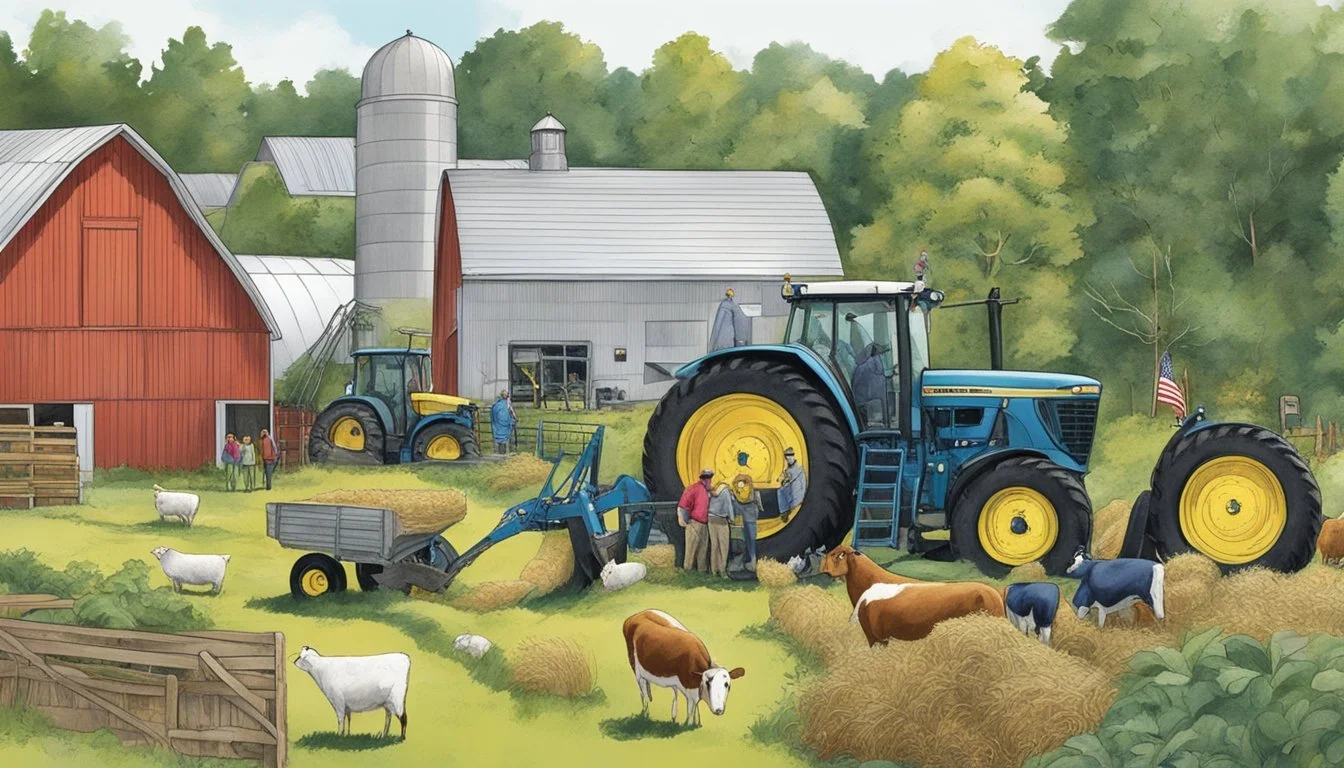Right to Farm Law in Maine
Understanding Agricultural Protections
Maine's Right to Farm Law, originally passed in 1981, reflects the state's commitment to support its agricultural community and preserve farmland. This law has been central in protecting farmers against nuisance suits which may arise from everyday farming activities such as the sounds and scents of agricultural operations. The law is designed to safeguard legitimate, properly-conducted farming efforts by asserting that these activities should not be deemed nuisances if they are in accordance with generally accepted agricultural practices.
Modifications to the law were made in 2008 under the Maine Agricultural Protection Act, which sought to fortify the law's preamble and more explicitly defend agricultural land use. These legislative protections are part of a broader array of statutes in place that prioritize farmland preservation and support the farming industry across Maine. Despite these measures, Maine has still observed a decrease in both the number and land area of farms since the law’s inception, raising questions about the changing dynamics of agriculture in the state.
The state's legal stance on farming was further reinforced with the passage of a constitutional Right to Food amendment in November 2021. This historic amendment emphasizes Maine's progressive approach to food sovereignty, aligning with the Right to Farm Law in promoting an environment where the practices and rights of farmers are respected and reinforced by law.
Historical Context
The historical context of Maine's Right to Farm laws is rooted in a nationwide movement to protect farming practices and began with legislation established decades ago.
Origin of Right to Farm Laws
Right to Farm laws emerged nationally as a response to conflicts between agricultural and non-agricultural land uses. The overarching goal was to shield agricultural operations from nuisance suits. Such suits often arose as residential areas expanded into previously rural, agriculture-dominated regions. The origin of these laws can be traced back to the desire to preserve a way of life deemed essential to the country's roots and economy while balancing the interests of both farmers and their non-farming neighbors.
Evolution in Maine
Maine passed its initial Right to Farm law in 1981. This law aimed to protect farms that conform to "generally accepted agricultural practices." Over time, the shifting scales of agriculture led Maine legislators to amend the law’s preamble in 2008, acknowledging the changing landscape of farming within the state. Specifically, Maine sought to further insulate agricultural land use as the number of farms and land dedicated to farming decreased over the years. The evolution of the law reflects both the reduction in farming activity and the state's commitment to safeguarding its agricultural heritage.
Core Principles
The Maine Right to Farm Law hinges on the protection of legitimate farm operations while promoting methods and practices considered standard and acceptable in the agricultural industry.
Definition of Farm Operations
Farm operations in Maine are not restricted to just the cultivation of soil or raising of livestock. They span a range of agricultural activities, including the production of crops, livestock, poultry, dairy, or aquaculture. By legislative definition, these operations are integral to the agricultural framework within the state, and the law serves to safeguard these operations from being deemed public or private nuisances, provided they adhere to lawful and normative practices.
Generally Accepted Agricultural Practices
To ensure that farm operations maintain harmony with their surroundings, it is imperative that they engage in Generally Accepted Agricultural Practices (GAAP), which are established standards within the farming community. Compliance with GAAP reinforces the legitimacy of farm operations by minimizing negative impact on the environment and local communities. Maine mandates that farms should not only follow GAAP but also employ Best Management Practices (BMPs) as outlined by agricultural authorities, which underscore the prudent and efficient use of resources in farming activities.
Legal Framework
The legal framework governing farming in Maine is grounded in several key pieces of legislation that provide protections and establish the rights of farmers. These laws balance the interests of agricultural professionals with those of their neighbors and the wider community.
Maine Agriculture Protection Act
The Maine Agriculture Protection Act is a cornerstone of farming legislation in the state. As a successor to the original Right to Farm Law, it was renamed and relocated to Title 7 of the state statutes governing agriculture. This Act provides a strong legal shield for farmers against nuisance complaints, as long as their operations adhere to standard agricultural practices.
Maine Right to Farm Law
Originally enacted in 1981, the Maine Right to Farm Law declares that farming operations cannot be considered a nuisance under certain conditions. This includes conformity to generally accepted agricultural practices and pre-existence before changes in local land use. The legislation has undergone revisions to ensure it remains relevant and effective in protecting farmers' rights.
Local Ordinances
Local ordinances in Maine often complement state farming laws. These ordinances typically support farmland preservation and can provide additional layers of protection for farmers. They address concerns such as noise, odor, and other aspects of farming that might affect local residents.
State and Federal Laws
Maine's agricultural sector is also subject to a range of other state and federal laws. These laws cover a broad spectrum of issues from environmental protection to food safety. For example, provisions under the Clean Water Act and various USDA regulations intersect with and impact farming practices and rights. Compliance with both state and federal regulations is imperative for Maine farmers to maintain operational legality and protection under the law.
Agricultural Practices
In Maine's agricultural sector, adherence to established practices plays a critical role in ensuring that farming activities are both sustainable and legally compliant. Two key components of these agricultural practices include Best Management Practices (BMPs) and the topic of farm registration.
Best Management Practices (BMPs)
Best Management Practices (BMPs) are a set of guidelines developed to help farmers implement the most effective and efficient agricultural techniques. These practices aim to balance farm productivity with environmental stewardship and are pivotal for a farmer's "Right-to-Farm" protection under the Maine Agriculture Protection Act.
Objectives of BMPs:
Reduce soil erosion
Minimize water contamination
Enhance wildlife habitat
Improve the quality of Maine's agricultural products
Registration
Unlike some states, Maine does not require farmers to register their farms. However, certain types of farm activities necessitate specific licenses. For instance, the sale of milk or processed foods produced on a farm requires appropriate licensing in line with state regulations. These regulatory measures ensure that agricultural operations meet health and safety standards.
Types of Licenses Required in Maine:
Dairy licensing for milk production
Food processing licenses for farm-produced value-added products
Farm Operation Challenges
In Maine's agricultural sector, farm operations often confront challenges related to their environmental impact, particularly in the realms of noise, odor, dust, and pollution control. These challenges can lead to tension between farm operations and surrounding communities.
Noise and Odor Complaints
Noise generated by farming equipment and livestock can be a source of friction between farm operations and nearby residents. The hum of machinery and the calls of animals are inherent aspects of farm activity. Maine's Right to Farm Law acknowledges these noises as part of normal farm operations, often shielding farms from nuisance lawsuits as long as they adhere to generally accepted agricultural practices.
Odor from manure or other organic waste is another common complaint from those living close to farms. Farms must balance their operational needs with the use of best management practices (BMPs) to mitigate odors, thereby maintaining compliance with relevant regulations and community standards.
Dust and Pollution Control
Farms must also navigate challenges pertaining to dust and pollution. Dust can arise from tilling, harvesting, or transporting crops, which can affect air quality and visibility. Practices are in place that aim to minimize dust emissions, ensuring farm operations do not negatively impact local air quality more than necessary.
Pollution control focuses on the management of nutrients, chemicals, and other potential contaminants. Farms are required to be consistent with the Maine Nutrient Management Act to prevent agricultural run-off from compromising water quality. Pollution control measures are crucial to ensuring the long-term sustainability of Maine's water resources and the surrounding ecosystem.
Protection of Farmland
In Maine, the safeguarding of farmland is upheld by robust legislation, including measures that secure the rights of farmers and classify agricultural land to encourage its preservation and proper use.
Farmland Protection Policies
Maine Agricultural Protection Act plays a crucial role in the protection of farmland. This Act encompasses the "Right-to-Farm Law", which shields farmers against neighborhood complaints related to the expected noise, odor, and other byproducts of routine farming activities as long as they are legitimate and conducted appropriately.
The state has implemented the Farmland Protection Program, offering financial incentives to landowners to support the longevity of farming. This includes tax relief measures under Maine's Farmland Property Tax Program, aimed at reducing property taxes on operational farmland.
Key Benefits:
Protection from nuisance lawsuits
Reduced property taxes for eligible farmlands
Agricultural Land Classification
Maine classifies land designated for agriculture to ensure it is used optimally for farming and related activities. The criteria for eligibility include:
A minimum of 5 contiguous acres of land
Generating a gross annual income of at least $2,000 from farm products
Landowners must present proof, demonstrating income from farming activities over specified years prior to applying for classification under the program. Such classification helps sustain the agricultural landscape and supports farmers in their endeavors. Requisite eligibility ensures that farmland is actively used for its intended purpose and is not merely labeled for tax advantages.
Classification Criteria:
Land Area: Minimum 5 acres
Farm Income: $2,000 minimum annual income from farming
The classification system underpins the broader goal of farmland protection, ensuring that agricultural property remains dedicated to farming, thereby contributing to the state's agricultural viability and heritage.
Farmer Rights and Responsibilities
Maine's Right to Farm Law functions as a safeguard for agricultural practices by delineating the rights and responsibilities of farmers, particularly in balancing farm operations with public interests and legal proceedings. It ensures farmers can undertake agricultural practices without undue risk of nuisance lawsuits, while also emphasizing their obligation to adhere to safety and public health standards.
Nuisance Laws and Litigation
Farmers are protected under Maine's Right to Farm Law from nuisance claims provided their operations meet certain conditions: they must comply with Best Management Practices (BMPs), adhere to the Maine Nutrient Management Act, or have been established prior to changes in land use within one mile of their operations — as long as they were not a pre-existing nuisance. This affords a level of certainty to farmers that their right to farm is recognized even if neighboring land uses evolve.
In the event of litigation, the burden of proof can often rest with the complainant to demonstrate that the farming operation violates statutory conditions. The existence of this law does not give carte blanche to agricultural operations; they must still be managed within the bounds of designated regulations to ensure the right is upheld.
Safety and Public Health
Safety and public health remain paramount in the considerations of the Right to Farm Law. Maine farmers are responsible for ensuring their practices do not negatively affect the wellbeing of the surrounding community. This encompasses the implementation of safety protocols in handling agricultural machinery, containment and management of livestock diseases, and the responsible use of pesticides and fertilizers.
Farmers are required to:
Maintain safe food-handling procedures.
Adhere to licensure requirements for certain products, such as milk.
Ensure any agricultural processing aligns with food safety laws.
Through these regulations, it is clear that while the state supports agricultural endeavors, there is also a strong commitment to maintaining a safe and healthy public environment. Compliance with these safety and health standards is critical for the ongoing operation and public acceptance of agricultural activities in Maine.
Community and Development
In Maine, the interplay between municipal land use regulations and the Right to Farm Law guides connections between communities and local agricultural development. These laws serve as a framework for balancing the growth of municipalities with the preservation of farmland.
Municipalities and Land Use
Municipalities in Maine exert control over local land use through zoning ordinances and development regulations. They are responsible for shaping communities by designating land for residential, commercial, or agricultural uses. Moreover, the Right to Farm Law intertwines with local land use policies, explicitly protecting agricultural practices from nuisance claims. This can often lead to a harmonization of community objectives with the needs of local farmers.
Zoning Ordinances: They dictate where farming is permissible and protect registered farmland.
Development Policies: Aim to balance urban expansion with the needs of agricultural preservation.
Development Pressures
Maine's agricultural areas face developmental pressures as urban sprawl and population growth demand more land. The Right to Farm Law has provisions that restrict incompatible development activities within proximity to registered farmland, aiming to mitigate these pressures.
Proximity Restrictions: Incompatible development is prohibited within:
50 feet of registered farmland, as per standard regulations.
100 feet of land registered between June 1st and June 15th of 1990 or 1991, provided continuous renewal has been maintained.
Furthermore, these regulations underscore Maine's commitment to balancing development with the sustainability of its agricultural sector, ensuring that farms remain integral to the community while facilitating responsible growth.
Education and Advocacy
Education and advocacy are pivotal for the effective implementation and comprehension of Maine's Right to Farm Law. Ensuring that stakeholders are well-informed promotes harmonious integration of agricultural practices within communities.
Workshops and Publications
Workshops provided to farmers and municipalities serve as a primary medium for educating all parties about the nuances of the Right to Farm Law. These workshops often include detailed breakdowns of the law, highlighting best management practices (BMPs) and ways to comply with the Maine Nutrient Management Act. Publications supplement these workshops, offering written resources that delve into statutory provisions and offer guidance for maintaining farms in ways that reduce the risk of public nuisance claims.
Maine Farm Bureau
The Maine Farm Bureau plays a crucial role in advocacy and education concerning the Right to Farm Law. This organization endeavors to support Maine's natural resource businesses through various educational initiatives. It actively disseminates information about legal requirements and agricultural best practices to both farmers and the communities they serve. Engaging with legislation and providing a clear understanding of farmers' rights and responsibilities are among the focal areas of the Maine Farm Bureau's work.
Additional Considerations
When discussing Maine's Right to Farm Law, it's crucial to consider the tax implications for agricultural lands and the legal oversight ensuring compliance with both state and federal regulations.
Farm and Open Space Tax Law
Maine's Farm and Open Space Tax Law presents a reduced property tax rate for farmlands, preserving agricultural vitality by incentivizing the designation of farmland as open space. To be eligible, the land must be primarily used for farming or is available as if it is farmed.
Eligibility Criteria: Farmland must be a minimum of 5 acres and actively used to grow plants or to keep animals which are used in the commercial production of food.
Benefits: Land is assessed based on its current use rather than potential development value, which often results in a lower tax burden.
Attorney General and ADA Compliance
The Attorney General holds a critical role in interpreting Maine's Right to Farm Law in relation to the Americans with Disabilities Act (ADA). They ensure that farm operations don't inadvertently violate ADA compliance while conducting legitimate agricultural practices.
Compliance Oversight: The Attorney General's Office provides guidance and oversight in cases where farm activities intersect with public accommodations under the ADA.
Educational Role: The office may also undertake an educational role to help farmers understand their responsibilities and rights under the ADA.
It's vital for Maine's agricultural community to be aware of these additional considerations, ensuring they can both benefit from the Right to Farm Law and remain compliant with legal requirements.











